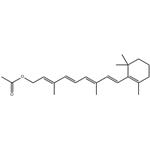- Retinyl acetate
-

- $99.00 / 1kg
-
2025-04-15
- CAS:127-47-9
- Min. Order: 1kg
- Purity: 99%
- Supply Ability: 5000 ton
- Retinyl acetate
-

- $0.00 / 1kg
-
2025-04-13
- CAS:127-47-9
- Min. Order: 0.10000000149011612kg
- Purity: ≥99%
- Supply Ability: 20tons
|
| | Retinyl acetate Basic information |
| | Retinyl acetate Chemical Properties |
| Melting point | 57-58 °C | | Boiling point | 406.22°C (rough estimate) | | density | 1.0474 (rough estimate) | | refractive index | 1.547-1.555 | | Fp | 14℃ | | storage temp. | 2-8°C | | solubility | absolute ethanol: 25 mg/mL | | form | solid or viscous liquid | | color | Yellow powder | | Odor | Amine like | | biological source | synthetic (organic) | | Water Solubility | soluble | | Sensitive | Light & Air Sensitive & Hygroscopic | | Merck | 14,10013 | | BRN | 1915439 | | Specific Activity | 475,000-650,000USP units/g | | Stability: | Hygroscopic, Light Sensitive | | InChIKey | QGNJRVVDBSJHIZ-QHLGVNSISA-N | | LogP | 9.4 at 25℃ | | CAS DataBase Reference | 127-47-9(CAS DataBase Reference) | | NIST Chemistry Reference | Retinol, acetate(127-47-9) | | EPA Substance Registry System | Retinol acetate (127-47-9) |
| | Retinyl acetate Usage And Synthesis |
| Description | Retinyl acetate (retinol acetate, vitamin A acetate,127-47-9) is a natural form of vitamin A. It is the acetate ester of retinol. It consists of yellow crystals which are greasy or sticky. It has a mild, characteristic odor. It has potential antineoplastic and chemo-preventive activities. It can be used to fortify food with vitamin A. As vitamin A acetate can induce cell differentiation and inhibit cell proliferation, it is used in skin-conditioning agent. | | Chemical Properties | Retinyl acetate is a yellow, prism-shaped crystal and a lipid-soluble compound, with better chemical stability than vitamin A. In clinical practice, either vitamin A acetate or its palmitate form is typically dissolved in vegetable oil for administration, where it is hydrolyzed by enzymes in the body to release active vitamin A. The form of vitamin A listed in the Chinese Pharmacopoeia refers to the active vitamin A compound. | | Uses | vitamin precursor | | Uses | Essential micronutrient | | Uses | Retinyl acetate has been used:
- a control diet to study its effect at different developmental periods in fish larvae
- to study its inhibitory effects on Mycobacterium avium?subspecies?paratuberculosis?(MAP) strains
- as an internal standard in high performance liquid chromatography (HPLC) to quantify vitamin A in fortified milk
| | Definition | ChEBI: Retinyl acetate is an acetate ester. It is functionally related to an all-trans-retinol. | | Preparation | A method for preparing retinyl acetate the following steps:
Under alkaline conditions, 3-methyl-4-oxo-2-butene-1-yl acetate (referred to as C5 aldehyde ester) and tetraethyl methylene diphosphate undergo a condensation reaction to form an intermediate C6 phosphate (chemical name: 5-(diethyl phosphate)-3-methyl-2,4-hexadiene-1-acetate).
Under alkaline conditions, the C6 phosphate undergoes a transposition reaction. C14 aldehyde (chemical name: 2-methyl-4-(2,6,6-trimethyl-1-cyclohexene-1-yl)-3-butene-1-aldehyde) is then added to undergo a Wittig-Horner condensation reaction, yielding retinyl acetate. | | General Description | Retinyl acetate is suitable for use in the retention identification of the analyte when using HPLC and GC. Not intended for use as an activity reference standard. It has been thoroughly evaluated to ensure the utmost quality. Neat, unless otherwise noted. Certificate of Composition provided with the purchase. | | Flammability and Explosibility | Not classified | | Biochem/physiol Actions | Retinyl esters provide pools of vitamin A that are converted into retinol and other retinoids as required. Retinyl acetate is used in a wide range of biological applications. It acts as a chemopreventive agent. Retinyl acetate also has antineoplastic property. | | Safety Profile | Moderately toxic by
ingestion. Experimental teratogenic and
reproductive effects. Questionable
carcinogen with experimental neoplastigenic
data. Mutation data reported. When heated
to decomposition it emits acrid smoke and
irritating fumes. See also VITAMIN A. | | Purification Methods | The acetate is separated from retinol by column chromatography, then crystallised from MeOH. [Kofler and Rubin Vitamins and Hormones (NY) 18 315 1960 for purification methods]. Store it in the dark, under N2 or Ar, at 0o. [Beilstein 6 IV 4135.] | | References | [1] Volker Bühler, Vademecum for Vitamin Formulations, 2001, ISBN 3-8047-1834-5
[2] SUNATDA ARAYACHUKEAT Thapakorn T U Supason P Wanichwecharungruang. Retinyl acetate-loaded nanoparticles: Dermal penetration and release of the retinyl acetate[J]. International Journal of Pharmaceutics, 2011, 404 1: Pages 281-288. DOI:10.1016/j.ijpharm.2010.11.019.
[3] HARRISON E H. Lipases and carboxylesterases: possible roles in the hepatic metabolism of retinol.[J]. Annual review of nutrition, 1998, 18: 259-276. DOI:10.1146/annurev.nutr.18.1.259.
[4] GERSTER H. Vitamin A–functions, dietary requirements and safety in humans.[J]. International Journal for Vitamin and Nutrition Research, 1997, 67 2: 71-90.
[5] https://ods.od.nih.gov/factsheets/VitaminA-HealthProfessional/ |
| | Retinyl acetate Preparation Products And Raw materials |
|